It was winter in Bangalore, the IT Capital of India. Winter drawing to a close, admittedly, seeing that it was almost the mid of January, but the air was still cool and venturing out hadn't started to feel quite like a chore yet. Karnataka boasts of a rich cultural heritage, and I had always wanted to visit the likes of Hampi. This seemed like the perfect opportunity for a weekend getaway. I breached the subject to Ela and, as expected, he was equally enthusiastic. He suggested taking his beloved car for the trip.
Ela had become the proud owner of a Tata Nano recently, and though we never ceased teasing him, he had travelled more than 10,000 kilometers in less than two months. Most of them during weekends on national highways, commuting from Bangalore to his hometown. I was a bit skeptical in the beginning, wondering if the Nano was capable of a trip covering almost 600 kilometers. However, he managed to convince me saying the Nano will only add to the thrill of the expedition.

Our itinerary included driving over to Shravanabelgola, night stop at Hassan and then next day to Halebidu and Belur before starting on our way back to Bangalore. We hadn't put much thought into the planning for the trip. The most we had done was arrange for printouts of the entire route traced on Google Maps.
Me being my usual lazy self, we started from Bangalore post a good lunch on Saturday. We hit a snag when we got caught in traffic on Bannerghatta Road. With a little bit of planning we could have avoided this stretch, but then that's being wise after the event. Once we hit the national highways, we made good progress.
The drive was a treat to the senses. The route passed through lush green forests, rural villages, lakes and paddy fields. Our chatter would have sounded like retro-holiday drivel. We were completely drowned in nature's beauty. John Schindler has said, "How easy and simple it is to live enjoyably when the simple, interminable blue of the sky, with its long wisps of white clouds, become a pleasant thing to behold, a thing of beauty that thrills you every time you care to look skyward."
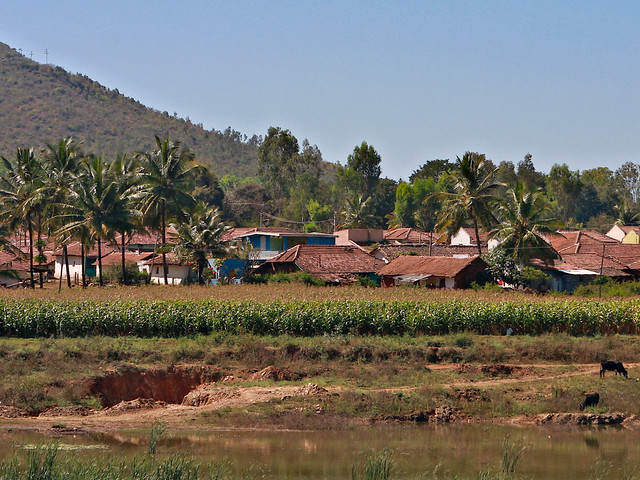
Making short stops for coffee, coconut water and clicking pictures, we reached our first destination, Shravanabelagola, around four in the evening. It has two adjacent hills - Vindhyagiri and Chadragiri. The statue of Lord Gommateswara Bahubali is on Vindyagiri. At 57 feet, it is the world's largest monolithic statue. To aid climbers, steps are cut directly into the stone face of the hill. Still, it's quite a steep climb. We were completely out of breath by the time we reached the summit and had to stop and take rest for a few mins. The view from the top was breathtaking. It reminded me of a few lines by the reclusive American mystic, Emily Dickinson.
Will fail of it above.
God's residence is next to mine
His furniture is love.
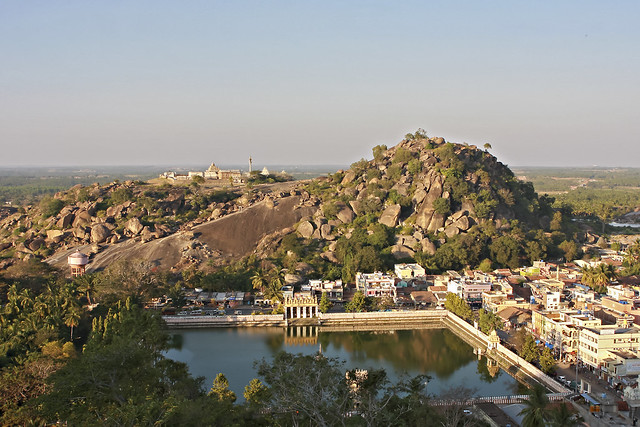
We took scores of pictures of the Jain basadi as the sun gradually disappeared behind the horizon. By the time we reached the statue of Lord Bahubali, the gates were being closed for the night. Fortunately for us, the priest was a kindly soul. He allowed us inside and provided a quick guided tour of the place. He even let us take a few shots before escorting us out as the doors were padlocked. We spent some more time on the hillock taking pictures and enjoying the beautiful view as dusk gave in to the darkening sky.
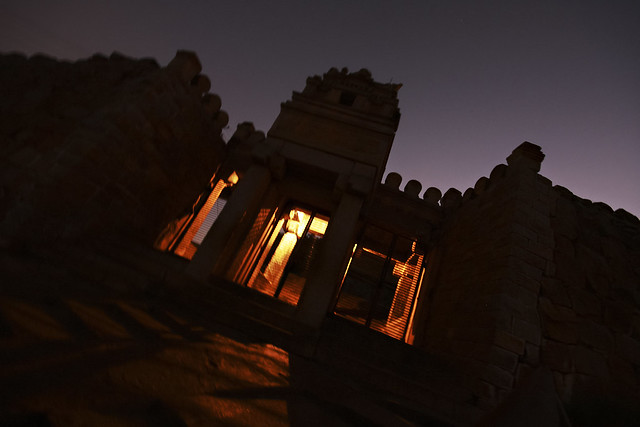
We had food at a roadside dhaba before checking into a hotel in Hassan. By morning nine, we were refreshed and ready to start on the onward journey. Driving through beautiful farmlands, suddenly a streak of purple caught our eyes. To our amazement, we saw some purple coloured flowers being cultivated in a big field. Having come upon an idyllic place, we found ourselves with a yearning to linger. Time stood still as beauty overwhelmed us. Another passing car stopped by, we exchanged greetings and then spent some silent moments clicking away trying to capture the moment.

We reached Halebidu around ten in the morning. The temple here has two adjoining shrines adjacent to each other - Hoyasaleswara and Shantaleswara, both dedicated to Lord Shiva. These temples date back to the 11th century and have never been completed. The city was repeatedly attacked and ransacked by the muslim invader Malik Kafur, leaving it in ruins. Halebid means "City in ruins".
This little town still attracts tourists in droves, and the fact that almost everything is in ruins doesn't seem to matter at all; it only adds to the charisma. This magnificent temple, built of soapstone, is one of the finest example of Hoyasala architecture. Ornate pillars, detailed miniature towers and intricate arrays of stone sculptures which includes elephants, lions, horses and episodes from the Indian mythological epics, Halebidu has everything. Perhaps no other Hoyasala temple is as sculpturally articulate as this is and these sculptures are second to none in all of India. The temple of Halebidu, has been described as an outstanding example of Hindu architecture and as the supreme climax of Indian architecture.

It was two in the afternoon before hunger pangs made us realize the time. We decided to have food in Belur and made the 16 kilometers drive in quick time. After a quick lunch in the Karnataka state run restaurant, we made our way to the Chennakesava temple in Belur. The beautiful Gopuram was the first to meet our sight. The temple in Belur is almost similar to the temple in Halebidu, even belonging to the same period. However, unlike Halebidu, here the shrine is dedicated to Lord Vishu. The architecture is equally impressive with beautiful stone sculptures all around the structure. There are 42 status of sensuous dancing maidens sculpted all around the temple. Walking through the ancient temples will send you through a time warp. Strewn across this land are civilization stunners, not just to be seen as postcards, but to be looked at as inheritances of the future generations given to us for safe keeping.
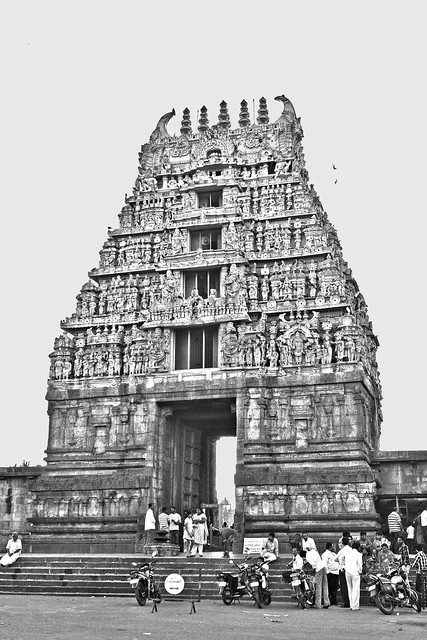
After taking some sunset shots, we started on the journey back to Bangalore. But our adventure was not over yet. Passing through the dark forest, we suddenly caught sight of a bright glow. Slowing for a closer look, we were astounded to see fire engulfing the surrounding trees in the forest. We soon realized it was not a wild fire running havoc through the forest, but rather one that will burn itself out in sometime. But, this being our first forest fire, we were quite excited and couldn't help stopping to take a few shots. The sight was mesmerizing, watching the yellow red flames quickly lick through the dry underbrush.
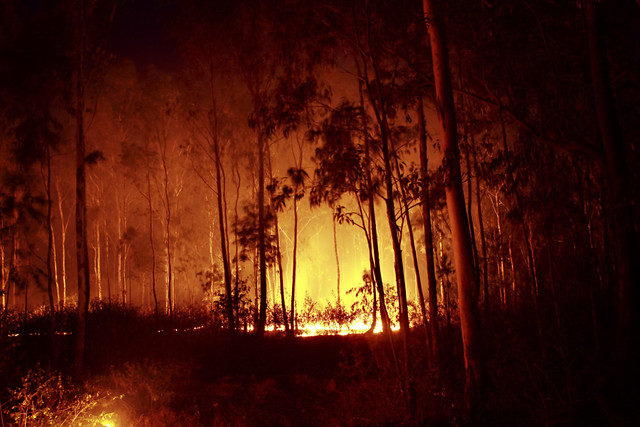
It was an incredible experience, travelling to such historic sites in a Nano. Many of my friends are still amazed how our little vehicle could make it through without breaking down. It was only possible due to our determination, carefree and sometimes reckless attitude, a strong zeal for adventure and quiet self-belief. The car lived up to more than our expectations and now I am a happy convert. The most important thing I realized from this trip is if you have a will, there is always a way!!


